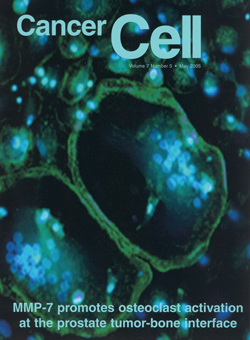
Team identifies mechanism of cancer-induced bone destruction
Researchers from Vanderbilt University Medical Center, the University of Nebraska Medical Center and Nagoya City University Medical School in Japan, recently uncovered a novel mechanism by which prostate cancer induces bone destruction, pointing to a potential new target for anti-cancer drugs.
In the May issue of Cancer Cell, Conor C. Lynch, Ph.D., postdoctoral fellow in Cancer Biology at VUMC and a Susan G. Komen grantee, and colleagues demonstrated that MMP-7 (matrix metalloproteinase-7) is a key factor in prostate cancer-induced bone destruction and a potential therapeutic target.
Prostate cancer, the second most common form of cancer in American males, is responsible for approximately 30,000 deaths each year. The majority of these deaths result from the spread of the tumor to other areas of the body, like bone.
Identifying the mechanisms of prostate cancer metastasis may pinpoint new therapeutic targets that could improve patient survival in this advanced stage of disease.
“Tumor cells can manipulate bone by activating the bone-destroying cells (osteoclasts). When bone is destroyed, it releases growth factors that in turn feed the tumor and provide the tumor space to grow. As the tumor gets bigger, it releases more factors, which recruit more osteoclasts to continue the vicious cycle,” said Lynch, postdoctoral fellow in the lab of Lynn Matrisian, Ph.D., and first author on the study.
RANKL, a protein normally found attached to the surface of bone-forming cells (osteoblasts) is essential for osteoclast maturation. To activate these bone-destroying cells, RANKL (on the osteoblasts) must bind to its receptor on osteoclasts.
“The hypothesis in the literature was that osteoclasts would have to come in direct contact with osteoblasts in a bone environment in order for the osteoclasts to become activated by RANKL,” Lynch said.
“But under the microscope, we never see these cells sticking together,” said Mitsuru Futakuchi, M.D., Ph.D., visiting postdoctoral fellow at the University of Nebraska Medical Center and senior author on the study.
Futakuchi had developed a rat model that demonstrated both types of bone changes, osteoclastic (bone-degrading) and osteoblastic (bone-forming), which are frequently observed in human cases of prostate metastasis to the bone. But the cells that needed to interact to activate these processes were never observed in close proximity.
“We wondered why and how the osteoblasts are activating osteoclasts if they are not touching,” Futakuchi said.
At a meeting in Nebraska last May, Matrisian listened as Futakuchi described his model of prostate cancer metastasis. In his model, he had found elevated expression of MMP-7 in bone lesions. Matrisian realized that her lab might have the answer to Futakuchi's question as to the role of MMP-7 in his model.
In vitro experiments completed by Lynch and Matrisian suggested that MMP-7, an enzyme known to directly degrade the extracellular matrix, could cleave RANKL from the osteoblast cell surface. This cleavage released a soluble active form of RANKL that could theoretically activate the distant osteoclasts.
“Our hypothesis was that if MMP-7 was present (at the bone-tumor interface), it could clip RANKL from the osteoblast, and that soluble, released form could interact with osteoclasts that are far away,” Lynch said. “So, basically, the cells don't have to be in direct contact.”
Futakuchi's model showed that MMP-7 was at the right place to be functioning in the way Lynch and Matrisian had proposed.
To verify that the soluble RANKL liberated from osteoblasts by MMP7 contributed to metastatic bone destruction, Futakuchi, Matrisian and Lynch worked together to adapt the rat model to mice. After transplanting rat prostate tumor to the skull of mice, they found that MMP7-deficient mice had much less soluble RANKL than control mice.
“After the surgery, we monitored the mice over three weeks using micro-CT technology at Vanderbilt's small animal imaging center, the VUIIS,” Lynch said. “We saw that there was a clear difference in the extent of bone destruction between the control and MMP-7-deficient mice after three weeks, whereby the MMP-7 deficient mice had much smaller bone lesions.”
“Therefore, we think that specific inhibition of MMP-7 would be of therapeutic benefit in curtailing tumor-induced bone degradation,” Lynch said.
Since there are few successful treatment options that can improve overall patient survival after cancer has spread to the bone, specific inhibitors of MMP7 could provide a promising new avenue for treating cancer metastasis.













